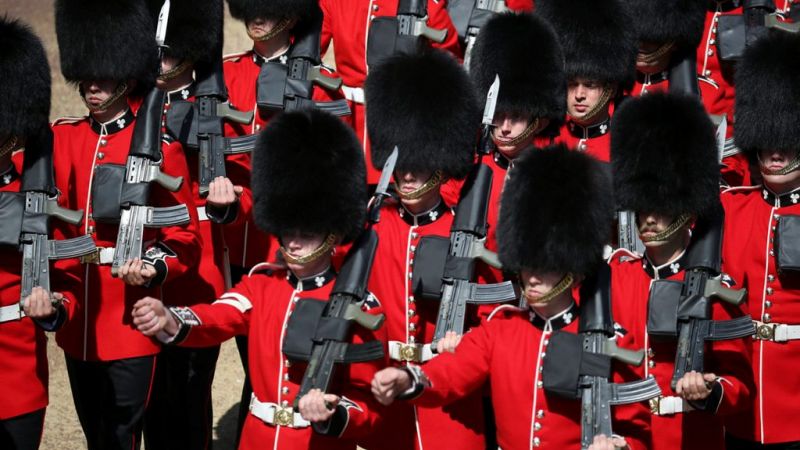
The Irish Guards, one of the five regiments of Foot Guards in the British Army, have a rich history and tradition of ceremonial splendor and operational excellence. Known for their distinctive Irish identity and close association with the British royal family, the Irish Guards have earned a reputation for their discipline, courage, and professionalism.
Historical Background
The Irish Guards were established by order of Queen Victoria on April 1, 1900, in recognition of the bravery displayed by Irish regiments during the Second Boer War. The creation of the regiment was part of a broader effort to acknowledge the contributions of Irish soldiers to the British military and to foster a sense of pride and identity among Irish servicemen.
From their inception, the Irish Guards have been involved in significant military campaigns. They fought in both World Wars, with notable engagements including the Battle of Mons, the Battle of the Somme, and the Normandy Landings on D-Day. The regiment’s service continued in post-World War conflicts, such as the Troubles in Northern Ireland, the Falklands War, the Gulf War, and more recently, operations in Iraq and Afghanistan.
Ceremonial Duties
The Irish Guards are renowned for their ceremonial duties, which are a key aspect of their service within the Household Division. They are responsible for guarding the royal residences, including Buckingham Palace, St. James’s Palace, and the Tower of London. The Changing of the Guard ceremony, in particular, is a major tourist attraction and a symbol of the regiment’s connection to the British monarchy.
Their ceremonial uniform is distinguished by a plume of St. Patrick’s blue in their bearskin caps and a shamrock motif on their buttons, reflecting their Irish heritage. The precision and discipline displayed by the Irish Guards during these ceremonies highlight their dedication to maintaining the highest standards of military tradition.
Operational Role
In addition to their ceremonial duties, the Irish Guards are a highly capable operational infantry regiment. Their training prepares them for a wide range of military operations, from peacekeeping missions to combat engagements. The regiment’s versatility and adaptability are essential to the British Army’s rapid deployment capabilities.
In recent decades, the Irish Guards have been deployed in various conflict zones, showcasing their operational effectiveness. They served in the Balkans during the Yugoslav Wars, took part in the invasion of Iraq in 2003, and were deployed in Afghanistan as part of the NATO-led International Security Assistance Force (ISAF). These deployments highlight the regiment’s ongoing commitment to global security and their ability to operate in diverse and challenging environments.
Training and Recruitment
Training for the Irish Guards is comprehensive and rigorous, ensuring that every soldier is prepared for both ceremonial and operational duties. Recruits undergo the standard 14-week British Army basic training before moving on to the Infantry Training Centre in Catterick for the Combat Infantry Course. This training includes weapons handling, tactical maneuvers, physical fitness, and ceremonial drill.
Recruitment into the Irish Guards is competitive, with an emphasis on selecting individuals who demonstrate physical endurance, mental resilience, and a strong sense of duty. The regiment attracts recruits from across the United Kingdom and the Commonwealth, fostering a diverse and inclusive environment that enhances its operational effectiveness.
Cultural Impact and Legacy
The Irish Guards have a significant cultural impact, symbolizing the valor and tradition of the British Army. Their presence at state events, such as royal weddings, state funerals, and the annual Trooping the Colour, underscores their role as key figures in the ceremonial life of the nation. The regiment’s music, particularly their regimental march “St. Patrick’s Day,” has become an integral part of British military and cultural heritage.
Their legacy is also marked by notable members, including various members of the British royal family who have served with the regiment, underscoring its close ties to the monarchy. Prince William, the Duke of Cambridge, was appointed Colonel of the Irish Guards in 2011, further cementing this connection. The regiment’s motto, “Quis Separabit” (Who Shall Separate Us), reflects their ethos of unity and loyalty.
Conclusion
The Irish Guards epitomize the blend of tradition and modernity that defines the British Army. From their origins at the turn of the 20th century to their current roles, they embody a unique combination of historical significance, ceremonial grandeur, and operational capability. Their commitment to serving the Crown and country ensures that they remain a vital part of Britain’s military and cultural landscape, living up to their motto “Who Shall Separate Us” in every aspect of their service.